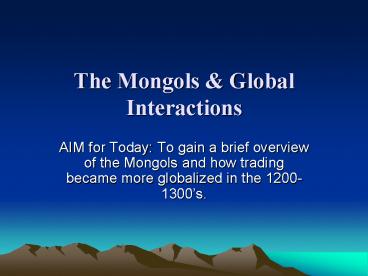The Mongols
1 / 20
Title: The Mongols
1
The Mongols Global Interactions
- AIM for Today To gain a brief overview of the
Mongols and how trading became more globalized in
the 1200-1300s.
2
3 Main Ideas About the Mongols
- They created the largest contiguous land empire
in world history, full of diverse lands and
peoples. - Mongol rule provided stability and prosperity.
- Mongol rule encouraged an exchange of goods and
ideas between East and West.
3
(No Transcript)
4
- Temujin (a.k.a. Genghis Khan), born in central
Asia in the 1100s. - gtgtHe became a courageous warrior and a skilled
leader, earning the title of Genghis KhanWorld
Emperor.
5
The Onon River in Mongolia, where Temujin was
born and grew up
6
- With well organized and disciplined armies,
Genghis Khan (G.K.), took most of Asiafrom Korea
in the east to the Caspian Sea in the west. - G.K.s armies advanced into Persia, India, and
northern China.
7
A Few Reasons for Their Success
- G.K.s armies were skilled horsemen and bowmen.
- They also borrowed new military technology, such
as cannons, from the Chinese and the Turks.
8
- During the time of G.K., the Mongols invaded
Eastern Europe, coming within reach of
Constantinople. - After G.K., the Mongols attacked Russia, Hungary,
and Poland. - G.K.s grandson Batu led Mongol armies known as
the Golden Horde in conquering many Russian
cities. They ruled from a capital on the Volga
River for 240 years.
9
Asia in 1200 CE
10
(No Transcript)
11
- Kublai Khan was another grandson of Genghis Khan
and he completed the job of conquering China. - He also ruled over Korea, Tibet, and parts of
Vietnam.
12
- Mongol warriors spread terror and destruction,
killing countless inhabitants of citiessuch as
those in modern day Kiev, Ukraine. - Despite brutality in war, most Mongol leaders
ruled with tolerance. For example, Genghis Khan
respected academics and artists. Conquered
peoples were often allowed to live as before, as
long as they paid tribute to the Mongols.
13
Pax Mongolia
- Political stability resulting from Mongol rule
allowed for the Pax Mongoliaa time of peace
during which goods were exchanged between East
and West. - The old Silk Road trade route between China and
the Middle East once again provided safe passage
and trade flourished (prospered/grew).
14
(No Transcript)
15
- Chinese products then flowed west, including
things such as gunpowder, porcelain, papermaking
technology and the use of windmills - MARCO POLO An Italian merchant who traveled to
Kublai Khans court in the late 1200s and
remained for many years. His writings introduced
many Europeans to the beauty and riches of China.
16
Undoing of the Empire
- The immense size of the Mongol Empire proved to
be its undoing. Under Genghis Khans descendants,
the empire was divided into separate, virtually
independent states. - Political rivalries and cultural differences led
to disunity (people being separated), and Mongol
cohesiveness (to stick together) dissolved. The
empire collapsed as the power of the states
disintegrated (dissolves) during the 14th and
15th centuries. - Citation www.encarta.com
17
- The Mongols also had little experience in
government so they chose others to do certain
jobs. Some of those people were corrupt or
incompetent (someone who doesnt know what
theyre doing). - In China Russia, people resented Mongol rule
and their desire for independence from foreign
rule provoked leaders to overthrow the Mongols.
18
Atlas Work, April 7th
- The Mongol Empire
- Turn to pp. 48-49
- Read intro. w. bullet pts. together unless we
already did this - How did the Mongol empire change from the time
periods of 1206-1279 from 1260-1405? - What were 3 of the major religions of the empire?
19
Ming Dynasty in China
- Turn to p. 50
- Read intro. w. bullet pts. Together
- Question B
- What is one major river in China?
- One major river in India?
- What was the first European settlement in China?
20
(No Transcript)































